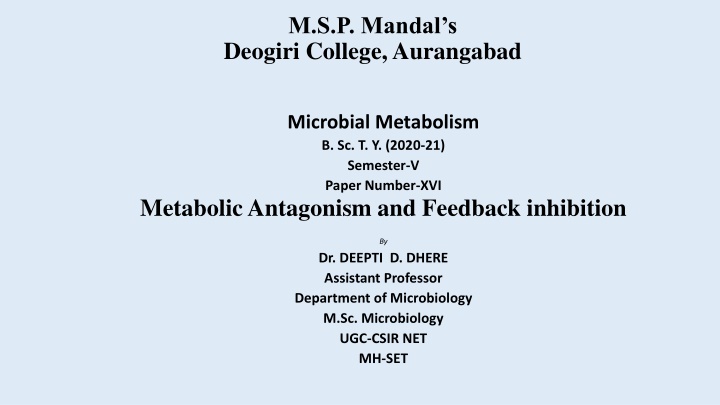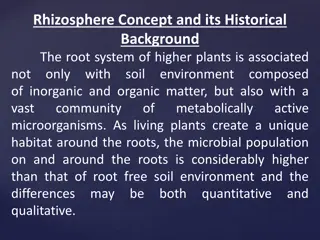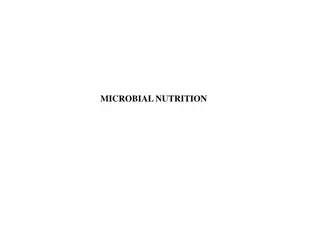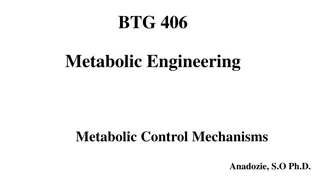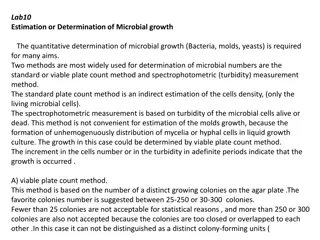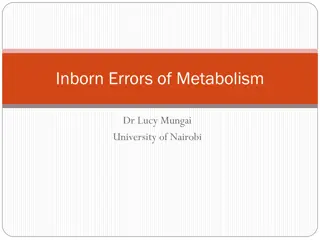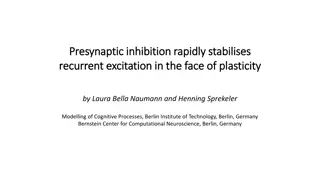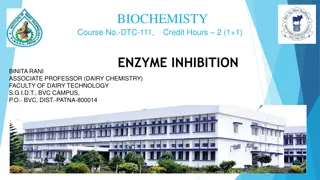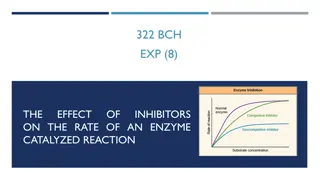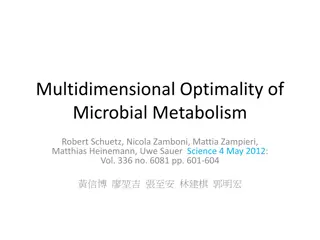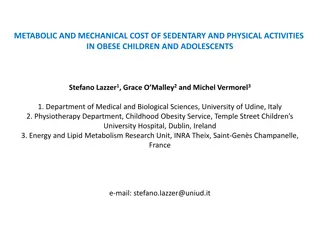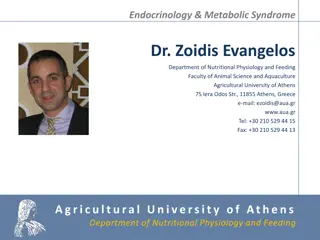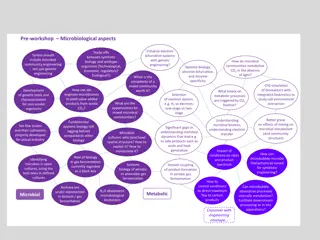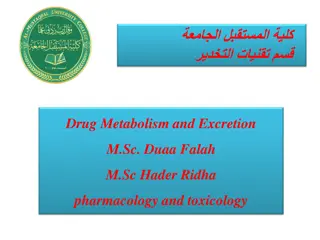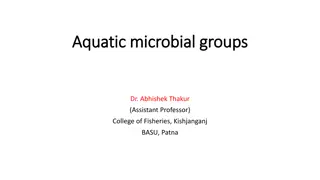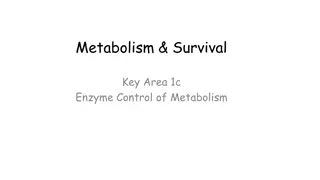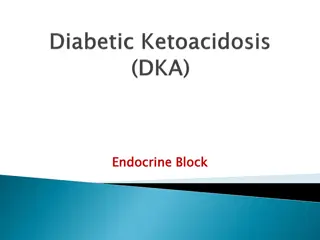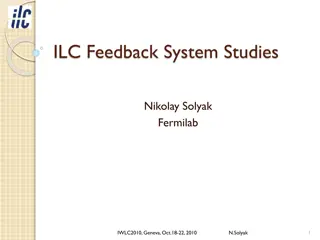Metabolic Antagonism and Feedback Inhibition in Microbial Metabolism
Metabolic antagonism involves the inhibition of metabolites by antimetabolites, affecting normal metabolism. Antimetabolites disrupt processes like DNA replication and cell growth, making them valuable in cancer treatment. Feedback inhibition regulates enzyme activity by end products, controlling pathway production. Understanding these mechanisms is crucial in microbiology studies.
Download Presentation

Please find below an Image/Link to download the presentation.
The content on the website is provided AS IS for your information and personal use only. It may not be sold, licensed, or shared on other websites without obtaining consent from the author.If you encounter any issues during the download, it is possible that the publisher has removed the file from their server.
You are allowed to download the files provided on this website for personal or commercial use, subject to the condition that they are used lawfully. All files are the property of their respective owners.
The content on the website is provided AS IS for your information and personal use only. It may not be sold, licensed, or shared on other websites without obtaining consent from the author.
E N D
Presentation Transcript
M.S.P. Mandals Deogiri College, Aurangabad Microbial Metabolism B. Sc. T. Y. (2020-21) Semester-V Paper Number-XVI Metabolic Antagonism and Feedback inhibition By Dr. DEEPTI D. DHERE Assistant Professor Department of Microbiology M.Sc. Microbiology UGC-CSIR NET MH-SET
Introduction What is Metabolic antagonism? It is the process in which antimetabolites inhibits the use of metabolites which is another part of normal metabolism is called as metabolic antagonism. What are antimetabolites? Antimetabolites are the chemicals which inhibits the use of metabolites, the antimetabolites are often similar in structure with the metabolites. e.g. Antifolates interfere with use of folic acid. Presence of antimetabolite can have toxic effect on cell, it can halt the cell growth and cell division. So, these compounds can be used in chemotherapy.
Function of antimetabolites 1. The antimetabolites can be used in cancer treatment as they interfere with DNA replication and hence, cell growth and division. 2. Antimetabolite may be an antibiotic such as sulphanilamide drugs which inhibit dihydrofolate synthesis in bacteria by competing with PABA (Para amino benzoic acid) is needed to synthesize folic acid where it acts as coenzyme in synthesis of purine and pyrimidines, the building blocks of DNA. 3. Anthracyclines are antitumor antibiotics that interfere with the enzyme involved in copying DNA during cell cycle. 4. The antimetabolites can be- Base analogue Nucleoside analogue Nucleotide analogue Antifolates
Antimetabolites are drugs that interfere with one or more enzymes or their reaction that are necessary for DNA synthesis. They affect DNA synthesis by acting as substitute to the actual metabolites that would be used in normal metabolism e.g. Antifolates interfere with the use of folic acid. Two types of antagonism.. Competitive (Reversible) and Non-competitive (Irreversible) Naloxone is competitive antagonist for opioid receptor Ketamine is non-competitive antagonist at NMDA-glutamate receptor. Methotrexate: Mechanism of action Cancer:-a folic acid antagonist that interfere/ inhibit DHFR (Dihydrofolate reductase) interfering with the synthesis of thymidylate, purine nucleotide and amino acid serine and methionine , hence formation of DNA, RNA and proteins.
Feedback Inhibition Feedback inhibition is a cellular control mechanism in which an enzyme s activity is inhibited by the enzyme s end product. This mechanism allows cells to regulate how much of an enzyme s end product is produced. Most biochemical processes are complex and multi-step, requiring multiple enzymes to get from the starting substrate to the desired end product. Typically, feedback inhibition acts on the first enzyme unique to a given pathway. For example, in the case of amino acid production, an amino acid may act as an inhibitor for the first enzyme in the pathway whose purpose is making more of that amino acid. An example of feedback inhibition is the inhibition of the activity of the enzyme hexokinase by glucose 6-phosphate in glycolysis. This enzyme catalyses conversion of glucose into glucose 6-phosphate but as the reaction proceeds, increase in concentration of glucose 6-phosphate inhibits the activity of hexokinase.
Production of Cholesterol Cholesterol is synthesized by the cell and in cell it is used to maintain integrity of cell membrane It also facilitate the signalling between the cells. Cell produces its own cholesterol if it is not available in the environment. Excess cholesterol production cardiovascular diseases. For this reason, high cholesterol in blood inhibits its own synthesis by feedback inhibition. lead to the
Amino acid production Amino acids are required as building blocks of protein. All amino acids share some common features while some are vey similar with each other. Cell needs different amino acids at different time and in different concentrations. The cell use feedback regulation to ensure that there will be synthesis of only amino acids which are required by the cell at respective time. The proteogenic amino acid L-serine is a precursor for various essential biomolecules in all organisms. 3-Phosphoglycerate dehydrogenase (PGDH) is the first committed enzyme of the phosphorylated pathway of l-serine biosynthesis, and is regulated by negative feedback from l-serine in bacteria and plants.
ATP Production ATP is produced by the cell through the series of biochemical reactions Glucose is the stable form of energy currency which is absorbed from food and transported throughout the body as per requirement. ATP is very unstable and can lose its energy spontaneously if it sits unused. Therefore it is very important to regulate the breakdown of glucose to formATP. Production of excessive ATP leads to energy loss and also deplete glucose. To control glucose breakdown to produce ATP, the first enzyme of catabolic pathway is allosterically regulated. If ATP binds to the first enzyme of the pathway it can inhibit its own synthesis.
Functions of Allosteric inhibition 1. Without feedback inhibition, energy or raw materials that could be used for important cellular function might be wasted on unnecessary ones. Feedback inhibition prevents depletion of the raw material and energy in biochemical pathway. It prevents dangerous built-up of the product which can be harmful to the cell It help to maintain homeostasis. An essential function of life is ability to maintain constant internal circumstances in changing environment. Some chemical messengers that are involved in maintained homeostasis are regulated through feedback regulation. 2. 3. 4. 5.
